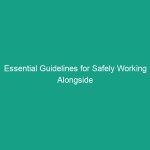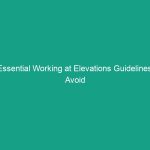Introduction
In an ever-evolving workplace landscape, the significance of Health, Safety, and Environment (HSE) practices cannot be overstated. Organizations are increasingly recognizing that a robust health and Safety culture is not just a regulatory requirement but a cornerstone of operational excellence. The process of Risk Assessment and Control Measures plays a pivotal role in identifying potential Hazards and mitigating risks, ensuring the Safety of employees and the environment. By implementing effective risk assessment strategies, organizations can not only comply with legal Standards but also foster a culture of safety that enhances employee morale and productivity.
This article delves into the essential components of risk assessment and Control Measures, exploring common pitfalls organizations face, the regulatory frameworks that guide these practices, and Best Practices for effective implementation. Through real-world examples and insightful case studies, we aim to equip you with the knowledge needed to navigate the complexities of Workplace Safety successfully.
Understanding Risk Assessment
Risk assessment is a systematic process that involves identifying, evaluating, and prioritizing risks associated with workplace activities. This fundamental aspect of health and safety management encompasses both qualitative and quantitative methods to ensure a thorough understanding of potential Hazards. The primary goal of risk assessment is to prevent workplace injuries and illnesses by proactively identifying risks before they materialize.
Types of Risk Assessments
There are several types of risk assessments, each serving a specific purpose:
- Qualitative Risk Assessment: This approach involves subjective evaluation based on expert judgment and experience, making it suitable for situations where quantitative data may be lacking.
- Quantitative Risk Assessment: This method relies on numerical data and statistical analysis, allowing for a more objective assessment of risks, particularly in high-stakes environments.
- Dynamic Risk Assessment: In environments that are constantly changing, dynamic risk assessments are crucial. They require ongoing evaluation and adjustment based on real-time conditions.
The Risk Assessment Process
The risk assessment process typically involves several key steps:
- Identifying Hazards: Begin by systematically identifying potential hazards in the workplace, including physical, chemical, biological, and ergonomic risks.
- Evaluating Risks: Assess the likelihood of each hazard leading to an incident and the potential severity of the outcome.
- Implementing Control Measures: Develop and implement strategies to mitigate identified risks, prioritizing controls based on their effectiveness.
- Monitoring and Review: Continuously monitor the effectiveness of control measures and review the risk assessment periodically or when changes occur in the workplace.
Regulatory Frameworks Surrounding Risk Assessment
Understanding the regulatory framework is essential for effective risk assessment and control measures. Different countries have established guidelines and legal requirements to ensure Workplace Safety. In the United States, the Occupational Safety and Health Administration (OSHA) sets forth Regulations that govern Workplace Safety standards. Similarly, the Health and Safety Executive (HSE) in the UK provides a comprehensive framework for risk management.
Key Regulations
Here are some key regulations that organizations should be aware of:
- osha Standards: OSHA mandates that employers conduct regular risk assessments and implement effective control measures to protect workers from hazards.
- Management of Health and Safety at Work Regulations: In the UK, these regulations require employers to assess risks and take appropriate measures to ensure the safety of employees and others affected by their activities.
- ISO 45001: This international standard outlines requirements for Occupational Health and safety management systems, emphasizing the need for risk assessment and control measures.
Common Pitfalls in Risk Assessment and Control Measures
Despite the best intentions, organizations often fall into common pitfalls when conducting risk assessments. Recognizing and addressing these pitfalls is essential for creating a safe workplace.
Inadequate Hazard Identification
One of the most significant pitfalls is failing to identify all potential hazards. This often occurs due to a lack of awareness, insufficient Training, or reliance on outdated assessments. To avoid this, organizations should encourage active participation from all employees, fostering a culture where safety concerns can be openly discussed.
Neglecting Employee Input
Employees are on the front lines and often have invaluable insights into workplace hazards. Ignoring their input can lead to incomplete assessments and overlooked risks. Engaging employees in the risk assessment process not only enhances the quality of the assessment but also promotes a sense of ownership over Workplace Safety.
Failure to Prioritize Risks
Risk assessments can become overwhelming if all risks are treated equally. Organizations must prioritize risks based on their potential impact and likelihood. Utilizing a risk matrix can help visualize and categorize risks, ensuring that resources are allocated effectively to address the most pressing concerns.
Inadequate Control Measures
Implementing control measures that are ineffective or inappropriate for the identified risks can lead to a false sense of security. Organizations should evaluate the effectiveness of existing controls and make necessary adjustments. Regular training and awareness programs can also reinforce the importance of adhering to safety protocols.
Neglecting Monitoring and Review
Risk assessments are not a one-time activity. Failing to review and update assessments in light of new information, changes in processes, or after incidents can expose workers to unnecessary risks. Establishing a routine for monitoring and reviewing risk assessments is crucial for maintaining an effective safety management system.
Best Practices for Effective Risk Assessment and Control Measures
To enhance the effectiveness of risk assessment and control measures, organizations should adopt the following Best Practices:
Engage Employees in the Process
Involving employees in the risk assessment process fosters a collaborative approach to safety. Regular safety meetings, training sessions, and feedback mechanisms can encourage open communication about hazards and control measures.
Utilize Technology and Data
Leveraging technology can streamline the risk assessment process. Software solutions can facilitate data collection, analysis, and reporting, making it easier to identify trends and areas for improvement. Utilizing data analytics can also enhance the accuracy of risk evaluations.
Implement a Safety Management System
Establishing a comprehensive safety management system allows organizations to integrate risk assessments into their overall safety strategy. This includes setting clear objectives, assigning responsibilities, and regularly reviewing performance against safety goals.
Conduct Regular Training
Continuous training is vital for ensuring that employees understand the risks associated with their work and the control measures in place. Regular training sessions should be tailored to address specific hazards and should incorporate real-life scenarios to enhance engagement.
Encourage Reporting and Feedback
Creating a culture that encourages reporting of hazards and near misses can significantly improve risk assessment processes. Organizations should implement anonymous reporting mechanisms and ensure that employees feel safe to voice their concerns without fear of repercussions.
Case Studies: Learning from Experience
Examining real-world case studies can provide valuable insights into the effectiveness of risk assessment and control measures. Here are a few examples that highlight both successes and failures in Workplace Safety:
Case Study 1: The Chemical Manufacturing Plant
A chemical manufacturing plant faced repeated incidents of chemical spills. After conducting a comprehensive risk assessment, the management identified that inadequate training and outdated safety protocols were major contributing factors. By implementing a new training program and updating safety Procedures, the plant significantly reduced spill incidents and improved overall safety performance.
Case Study 2: Construction Site Safety
A construction company experienced a high rate of accidents due to falls. A thorough risk assessment revealed that inadequate Fall Protection measures were in place. By prioritizing Fall Hazards and implementing effective control measures such as guardrails and Personal Protective Equipment, the company was able to reduce fall-related injuries by over 50% within a year.
Case Study 3: Office Workplace Ergonomics
An office environment provided employees with standard desks and chairs, leading to a rise in musculoskeletal disorders. A risk assessment focused on ergonomics identified the need for adjustable workstations. By investing in ergonomic furniture and training employees on proper posture, the organization saw a significant decrease in reported discomfort and related absenteeism.
Challenges in Implementing Risk Assessment and Control Measures
While organizations strive to implement effective risk assessment and control measures, several challenges may arise:
Resource Constraints
Limited budgets and resources can hinder the ability to conduct thorough risk assessments and implement necessary control measures. Organizations must prioritize safety and allocate appropriate resources to ensure effective risk management.
Cultural Resistance
In some workplaces, there may be a cultural resistance to change, making it challenging to implement new safety protocols. Leadership must champion safety initiatives and foster an environment where employees feel empowered to embrace change.
Complex Regulations
Navigating the complex web of regulations can be daunting for organizations, especially those operating in multiple jurisdictions. Seeking expert guidance and staying informed about regulatory changes can help organizations maintain compliance.
Keeping Pace with Technological Advances
The rapid evolution of technology presents both opportunities and challenges for risk assessment. Organizations must stay abreast of technological advancements that can enhance safety while ensuring that employees are trained to use new tools effectively.
Future Trends in Risk Assessment and Control Measures
The landscape of risk assessment and control measures is continually evolving. Here are some emerging trends that organizations should watch for:
Increased Use of Artificial Intelligence
Artificial intelligence (AI) is revolutionizing risk assessment by enabling more accurate data analysis and predictive modeling. AI tools can identify patterns in workplace incidents and suggest proactive measures to mitigate risks before they escalate.
Focus on Mental Health and Well-being
As awareness of mental health issues in the workplace grows, organizations are beginning to recognize the importance of assessing psychological risks alongside physical hazards. Implementing mental health initiatives can contribute significantly to overall workplace safety.
Integration of Safety into Corporate Strategy
More organizations are integrating safety into their core business strategies, recognizing that a strong safety culture can drive business success. This holistic approach to risk management ensures that safety is prioritized at all levels of the organization.
Conclusion
Effective risk assessment and control measures are vital for ensuring workplace safety and compliance with regulatory requirements. By understanding the common pitfalls, best practices, and emerging trends, organizations can navigate the complexities of workplace safety more effectively. Remember, safety is not just a checkbox; it’s a continuous commitment to creating a safer and healthier work environment for everyone.
As you reflect on your organization’s safety practices, consider conducting a comprehensive review of your risk assessment processes. Engage your employees, leverage technology, and prioritize a culture of safety. Together, we can avoid common pitfalls and build a safer future.


